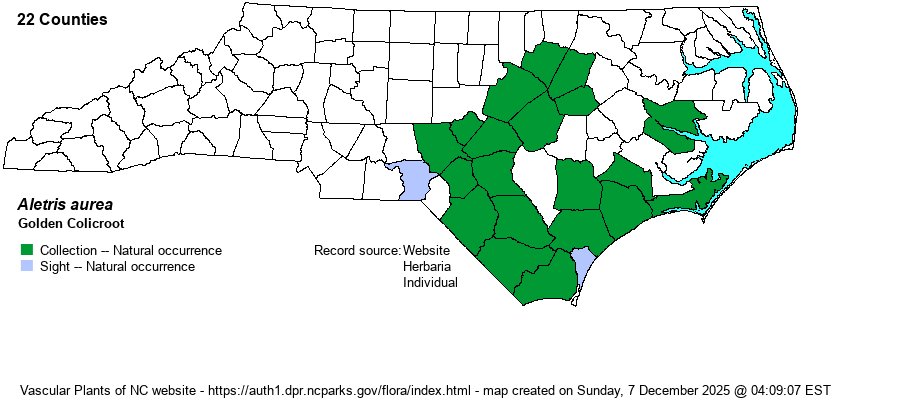| Author | Walter | |
| Distribution | Primarily the southern half of the Coastal Plain and the Sandhills, extending northward to the northeastern edge of the Piedmont. Ranges in the state north to Beaufort, Nash, and Franklin counties; however, it ought to be present in the northern Coastal Plain, as it occurs in southeastern VA and MD. Of spotty occurrence in the central Coastal Plain.
This is a Coastal Plain species, ranging from southern MD and southeastern VA south to northern FL, and west to southeastern OK and eastern TX. It ranges sparingly into the Piedmont province. | |
| Abundance | Infrequent in the southeastern Coastal Plain and Sandhills region. Very rare in the eastern edge of the Piedmont and the northwestern portion of the Coastal Plain. | |
| Habitat | This species occurs mainly in wet pine savannas, as well as in moist pine flatwoods. It also can be found in seepage areas with pitcher-plants and in blackwater streamhead ecotones. |
| Phenology | Blooms from mid-May into July; fruits mainly in August. As Weakley (2018) points out, it blooms a few weeks later than the more common Aletris farinosa where both occur together. | |
| Identification | This is a quite striking plant when in bloom, but it is easily overlooked otherwise. It has a cluster of fairly short and narrow basal leaves to about 2 inches long, but it sends up a slender flowering scape to about 15-18 inches tall, with somewhat widely scattered small golden-yellow flowers. Each flower is only about 1/4-inch long, barrel-shaped and quite rough and "mealy" to the touch. In fact, these yellow "balls" hardly look like flowers at all, and look more like capsules! It could be confused in NC only with the extremely rare A. lutea, which was discovered in 2011. As that species also occurs in savannas, the feature to look for is the shape of the flowers; A. lutea has narrower flowers with slightly flared tepals, such that the flower has a distinct opening. A. aurea flowers are more rounded in shape and the tepals are curved so that there is barely an opening into the flower. You should be able to see a few Golden Colicroots if you walk in some coastal savannas in June or early July. | |
| Taxonomic Comments | None
| |
| Other Common Name(s) | Yellow Colicroot (the usual common name for Aletris lutea). The iNaturalist website names it as Golden Miller's-maid! Where did that bizarre idiosyncratic name come from? | |
| State Rank | S3? [S3] | |
| Global Rank | G5 | |
| State Status | | |
| US Status | | |
| USACE-agcp | FACW link |
| USACE-emp | FACW link |

